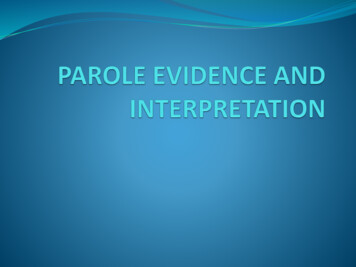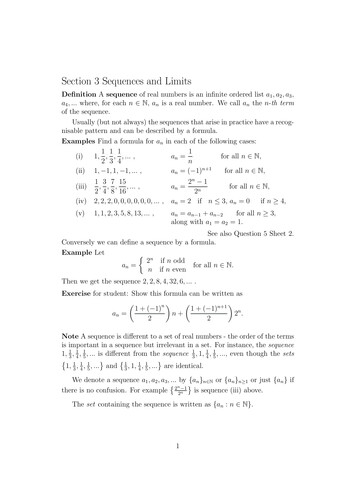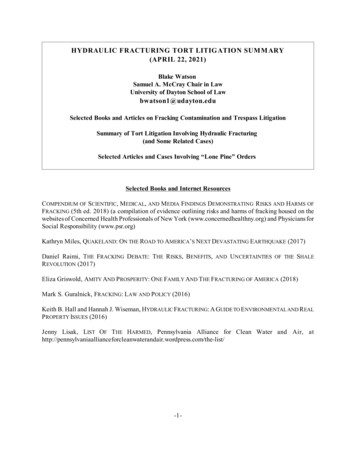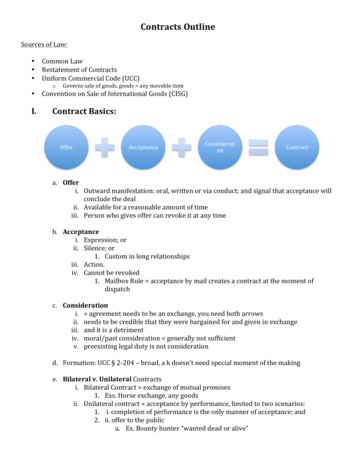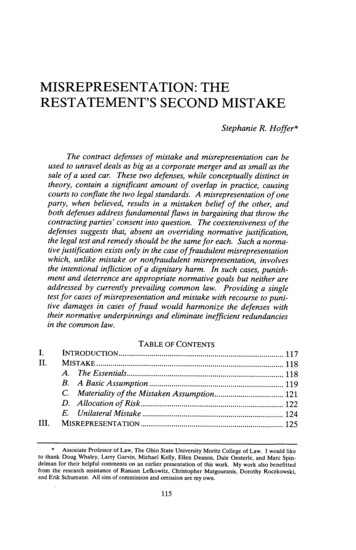
Transcription
MISREPRESENTATION: THERESTATEMENT'S SECOND MISTAKEStephanie R. Hoffer*The contract defenses of mistake and misrepresentation can beused to unravel deals as big as a corporatemerger and as small as thesale of a used car. These two defenses, while conceptually distinct intheory, contain a significant amount of overlap in practice, causingcourts to conflate the two legal standards. A misrepresentationof oneparty, when believed, results in a mistaken belief of the other, andboth defenses addressfundamentalflaws in bargainingthat throw thecontractingparties' consent into question. The coextensiveness of thedefenses suggests that, absent an overriding normative justification,the legal test and remedy should be the same for each. Such a normative justification exists only in the case offraudulent misrepresentationwhich, unlike mistake or nonfraudulent misrepresentation,involvesthe intentional infliction of a dignitary harm. In such cases, punishment and deterrence are appropriatenormative goals but neither areaddressed by currently prevailing common law. Providing a singletest for cases of misrepresentationand mistake with recourse to punitive damages in cases of fraud would harmonize the defenses withtheir normative underpinnings and eliminate inefficient redundanciesin the common law.TABLE OF CONTENTS1.II.INTRO D U CTIO N . 117M ISTA K E . 118A.B.C.D.E.III.The Essentials.A Basic A ssumption .Materiality of the Mistaken Assumption .A llocation of R isk .UnilateralM istake .M ISREPRESENTATION .118119121122124125*Associate Professor of Law, The Ohio State University Moritz College of Law. I would liketo thank Doug Whaley, Larry Garvin, Michael Kelly, Ellen Deason, Dale Oesterle, and Marc Spindelman for their helpful comments on an earlier presentation of this work. My work also benefittedfrom the research assistance of Ranaan Lefkowitz, Christopher Matgouranis, Dorothy Roczkowski,and Erik Schumann. All sins of commission and omission are my own.
UNIVERSITY OF ILLINOIS LAW REVIEWIV.[Vol. 2014A. An Assertion Not in Accord with the Facts.B. Fraudulentor Material Misrepresentation.1. FraudulentMisrepresentation.2. M aterialM isrepresentation.3. Dichotomy on Paper,Mess in Real Life .C. Justified R eliance .126128128129129131D. Inducing Assent of the Counterparty.134MISTAKE AND MISREPRESENTATION: A COMPARISON OFA PPLES TO A PPLES9 . . . . . . . . . . . . . . . . . . . . . . . . . .A.B.C.D.V.MisrepresentationResults in a Mistaken Belief .Inducement .Fraudulenceor M ateriality.Justified Reliance and Risk Allocation .1. Justified Reliance Is Impossible in the Face ofConscious Ignorance.2. Justified Reliance and Express Allocation of Risk .3. Justified Reliance and Allocation of Risk by Courts.4. Risk of Mistake, Though Similar,Is Broader ThanJustified R eliance .E. Comparisonof Remedies: Fraud's FailedAttempt to Gothe Extra M ile .A COMBINED D EFENSE .A. A Combined Defense Is Better Than Separate Defenses .B. PushingBack Against a Combined Defense.C. Elements of a Combined Defense .1. Focusingon Adverse Effect .2. Materialityof the Misconception.3. Protecting Expectations of 153155155156156157ProtectingCounterpartiesfrom Conscious Ignorance. 157b.ProtectingCounterparties Mhere an AdverselyAffected Party Has Explicitly Assumed Risk .i. Barring a MisrepresentationDefense on theBasis of Explicitly Assumed Risk Prejudices theAdversely Affected Party.ii. Refusal to Bar a Combined Defense on the Basisof Explicit Assumption of Risk in All CasesPrejudices the Nonadversely Affected PartyinSom e Cases.iii. The Assumption of Risk Bar Should Extend Only SoFarAs The Parties'Bargained-ForAllocation of Risk.D. Choosing a Remedy: ProtectingNormative Underpinningsof the FraudD efense .1. D isgorgement of Profit.2. Punitive D amages .158159160161163163165
No. 11MISREPRESENTATIONTort Law, State Statute, and Restitution in theNoncontractualContext Close Misrepresentation'sNormative to Positive Gap . 165165i. The Tort of Deceit .ii. DistinguishingFraudfrom Nonfraudulent167M isrepresentation.170.iii. State Statutory ProtectionsAgainst Fraudiv. RestitutionaryRemedies in the Noncontractual171Con text .1723. Sum m ary on Rem edies .172CONCLU SIO N .a.V.I.INTRODUCTIONThe Restatement Second of Contracts presents mistake and misrepresentation-two defenses against enforcement of a contract-as relatedbut conceptually distinct doctrines. They are, however, more than merecousins. Nearly complete overlap in the factual bases for cases of misrepresentation and mistake makes these doctrines more like fraternaltwins. The result is confusion among courts, litigants, and students.Consider, for instance, two examples. In the first, Betty acquires a business from Sam (or, if you prefer, B Corp acquires S Corp). Neither partyknows that accounting irregularities have caused Sam to grossly overvalue the business' accounts receivable. When Betty discovers this fact, shewill try to unravel the deal by raising a defense of mutual mistake. Shewill do this because both she and Sam have made a faulty assumptionabout a foundational aspect of the contract. But her case could also beone of material misrepresentation; Sam unintentionally made a materialmisstatement of fact upon which Betty relied when deciding to acquirethe business. So, to reiterate, Betty has two viable defenses: mistake andmisrepresentation. Now consider a second example in which Sam isaware of the accounting irregularities and deliberately misleads Betty.This is an obvious case of fraudulent misrepresentation since Sam lied toBetty, but it could also be a case of unilateral mistake, since Betty waslaboring under an important false assumption when she acquired thebusiness. Once again, Betty can invoke both mistake and misrepresentation. Notably, under any of these four permutations of Betty's case, shemay avoid her contract with Sam, and she may be entitled to restitution.Why, then, do we have two distinct defenses to reach a single result?This Article makes five claims based on the common ground sharedby the contract defenses of misrepresentation and mistake. First, misrepresentation is merely a case of instigated mistake. Second, although theirmechanisms are different, mistake and misrepresentation both addressthe same adverse effect: each produces a failure of consent resulting from
UNIVERSITY OF ILLINOIS LAW REVIEW[Vol. 2014at least one party's misconception of the facts. Third, because both doctrines take aim at the same failure of consent, the legal test and remedyshould be the same for each, absent an overriding normative justificationfor separating the two. Fourth, there is no compelling normative reasonfor retaining nonfraudulent misrepresentation as a defense separate frommistake. In such cases, a combined defense would suffice. Finally, whilethere are compelling normative justifications for retaining fraudulentmisrepresentation as a separate concept in contract law, such as punishment and deterrence, the proper way to realize these justifications is notin the determination of a remedy's availability, but rather in the determination of the remedy itself.Parts II and III of this Article will briefly describe the common lawof mistake and misrepresentation. Part IV will compare and contrastthese two defenses and will highlight the ways in which redundanciescause courts to conflate them. Part V sets forth justifications for combining the defenses of mistake and misrepresentation and describes howmistake and misrepresentation may be combined into a single defense ofmisconception. Part VI concludes that a combined defense could preserve and strengthen the unique normative considerations underpinningthe fraud defense by permitting courts to award punitive damages in cases of misconception arising through fraud.II. MISTAKEA.The EssentialsMistake occurs when a party to a contract misperceives informationthat is central to the bargain.' As a result, his consent to the bargain isflawed.' For example, if Professor Jacobi purchases a Prius from Professor Bilz believing that it is mechanically sound when the engine is actually a hunk of junk, she has not truly consented to the purchase. Her beliefin the car's mechanical integrity is a mistake.' A contracting party who isadversely affected by a mistake, such as Professor Jacobi (who now mustpay thousands of dollars to repair the car), can avoid a failed bargain ifcertain criteria are met.4 To be voidable under the Restatement, a con-tract must involve a mistake "as to a basic assumption on which the contract was made," and the mistake must have "a material effect on theagreed exchange of performances." 5 In addition, the party seeking toavoid a bargain must not bear the "risk of mistake. '6 In other words, the1. See RESTATEMENT (SECOND) OF CONTRACTS § 151 (1981) ("A mistake is a belief that is notin accord with the facts.").2. See id. For an interesting article on failure of consent in mistake cases, see Nancy Kim, Mistakes, Changed Circumstancesand Intent, 56 KAN. L. REv. 473 (2008).3. RESTATEMENT (SECOND) OF CONTRACTS § 151 (1981).4. See id. §§ 152,153.5. Id. § 152.6. Id.
No. 11MISREPRESENTATIONmistake must regard a matter that is important to the contracting parties,and the party seeking to escape her contractual obligations must not belegally on the hook for the apparent failure of her assumption. Finally,when only one party is mistaken, the contract is not voidable unless oneof the following is true: the mistake renders enforcement of the contractunconscionable, the nonmistaken party had reason to know of the mistake, or a fault of the nonmistaken party caused the mistake.7The Restatement formulation of mistake highlights three movingparts: the essential nature of the assumption in question, the materialityof that assumption to the parties' exchange, and allocation of the risk of amistaken assumption.s Each of these moving parts finds a corollary inthe Restatement's formulation of misrepresentation. A comparison ofthe two defenses will reveal that they differ not in the harm that theyseek to redress but in their will to punish a culpable actor. Similarities inthe harm and its mechanical production justify consolidation of the twodoctrines into one, with culpability of bad actors addressed through anexpansion of available remedies. Before reaching that point, it is important to confirm that the two doctrines are, as asserted, essentially twosides of the same coin. What follows is a more detailed discussion of mistake, followed by a similar discussion of misrepresentation.B.A Basic AssumptionAccording to the Restatement, a contract premised on a mistake isnot voidable unless the mistake regards "a basic assumption on which thecontract was made."9 Although this language is facially satisfying-weunderstand that the mistaken assumption must be an important one-itis vague. Does it mean that the assumption is so important that it induced assent? What if it contributed to, but did not induce, assent?What if it regarded a background condition to which the parties neverdevoted a single thought? Is the inquiry objective or subjective? Courtsand commentators have struggled to define the term and to determinewhen a mistake is fundamental enough to warrant rescission. 10The Restatement commentary clarifies the meaning of "basic assumption" somewhat, through both cross-reference to the doctrines ofimpracticability and frustration of purpose, and through a series of ex7. Id. § 153.8. Id. § 152 cmt. a.9. id. § 152(1).10. See, e.g., Reliance Fin. Corp. v. Miller, 557 F.2d 674, 680 (9th Cir. 1977) (stating that themeaning of materiality in cases of mistake and misrepresentation "may really encompass the samefacts and concerns, although articulated in different terms"); Melvin A. Eisenberg, Mistake in ContractLaw, 91 CALIF. L. REV. 1573, 1575 (2003) (noting that many rules that govern the mistake defense"are either of limited functional significance or are easy to verbally manipulate"); Hoffman F. Fuller,Mistake and Errorin the Law of Contracts, 33 EMORY L.J. 41, 91 (1984) (observing that outside of obvious cases, "a court is free to do as it chooses, set loose to sail on an ocean of subjectivity"); JamesGordley, Mistake in Contract Formation, 52 AM. J. COMP. L. 433, 434-42 (2004) (writing that mostcourts across the world allow relief when a mistake goes to something akin to the basic "substance" ofthe deal, but the term "substance" is not well understood).
UNIVERSITY OF ILLINOIS LAW REVIEW[Vol. 2014amples." Like mistake, both impracticability and frustration address thefailure of a basic assumption underlying the contract.12 Also like mistake,the Restatement sections applicable to impracticability and frustrationdefine "basic assumption" through cross-reference, this time to U.C.C.§ 2-615.11 This section, which may excuse a party's performance as a result of the failure of presupposed conditions, deals primarily with situations such as failure of a crop or destruction of the goods for which theparties contracted. 4 As such, it does not shed much light on the meaningof "basic assumption" in the context of mistake, except perhaps to tell usthat an assumption is basic when it deals with things at the heart of thedeal.In case law, a basic assumption is one that "relates to the basis of16the bargain. ."1 It need not be expressed as part of the agreement."In fact, the more basic the assumption, the less likely it is that the assumption will be articulated."' 7 It is the "very basis for the contract."' 8Furthermore, a basic assumption affects what a party may be willing toaccept as consideration for the contract. 9 Some courts go even furtherthan this, asserting that the mistaken assumption "must go to the essenceof the object in view, and not be merely incidental. The court must besatisfied that but for the mistake the complainant would not have assumed the obligation from which he seeks to be relieved."20 For instance,the authenticity of a rare violin for purchase,21 the existence of insurancecoverage in a contract for secondary insurance 22 the amount of propertysold in a real estate transaction, 23 and the structural integrity of a newlypurchased home's foundation 24 have all been held by courts to be basicassumptions upon which contracts were grounded.11. RESTATEMENT (SECOND) OF CONTRACTS § 152 cmt. b (1981).12. See Kim, supra note 2, at 473. Defenses based on basic assumption include mutual mistake,unilateral mistake, impossibility, frustration of purpose, and commercial defenses. Id.13.14.15.16.1992).17.RESTATEMENT (SECOND) OF CONTRACTS, ch. 11, intro, note (1981).U.C.C. § 2-615, official cmt (2004).Consol. Rail Corp. v. Portlight, Inc., 188 F.3d 93, 96 (3d Cir. 1999).See Hillside Assocs. of Hollis, Inc. v. Me. Bonding & Cas. Co., 605 A.2d 1026, 1030 (N.H.Id.18. Id.19. In re Barrister's Land Co., 57 B.R. 863, 866 (Bankr. N.D. Miss. 1985).20. Knudsen v. Jensen, 521 N.w.2d 415, 418 (S.D. 1994) (emphasis omitted) (quoting Beatty v.Depue, 103 N.W.2d 187, 191-92 (S.D. 1960).21. See Bentley v. Slavik, 663 F. Supp. 736, 741 (S.D. Ill. 1987) ("[I]t is clear the basic assumptionthat the violin was a Bernardel materially affected the agreed price, the exchange of performance.").22. See Hillside Assocs. of Hollis. Inc. v. Me. Bonding & Cas. Co., 605 A.2d 1026, 1030 (N.H.1992) (Unknown to the purchaser and insurer, Aetna was already providing requested coverage; thus,the purchaser had no need of insurance, and the bargain was based on a false premise).23. In re Barrister's, 57 B.R. at 866 ("The quantity of the real property to be conveyed was clearly the 'basic assumption' on which the contract was made . ").24. See Knudsen, 521 N.w.2d at 418 ("Knudsens asked about the fitness of the wooden foundation and were told that Jensens had encountered no problems with the wood foundation and it waspossibly the reason the house was so energy efficient. Knudsens entered the contract under the assumption the house was structurally sound.").
MISREPRESENTATIONNo. 1]Three case-based observations are in order. First, courts have described a spectrum of gravity when determining whether a mistake regards a basic assumption. On one end of the spectrum is a mistaken belief that affects the amount of consideration the adversely affected partywould be willing to accept. On the other end, a mistaken belief is thebut-for cause of the adversely affected party's acceptance of a deal.There is no fixed cut-off point at which a mistake rises to the level of abasic assumption. Second, like the analyses of materiality and inducement in misrepresentation, these determinations are highly fact-bound,leaving courts not with a rule that can be consistently applied but with atremendous amount of discretion to reach a result that reflects the effectof a particular mistake on the parties' exchange of performances. Thiscommon law grant of discretion mirrors the ability of courts to draw upon concepts of equity in cases of misrepresentation. Third, judicial determinations of whether an assumption is basic have bled into courts'analyses of a separate Restatement requirement, which is whether themistaken belief also had a material effect on the parties' performances.As discussed below, a similar analysis of materiality is required in casesof misrepresentation. These three observations militate against the conclusion that mistake is separable from misrepresentation on the groundsthat the basic assumption test sets a higher bar than the correspondingportions of the misrepresentation defense. To the contrary, like relatedportions of the misrepresentation defense, the basic assumption test is afact-specific moving target that produces an array of decisions more akinto arrows scattered around a bull's eye than to a bright line.C. Materialityof the Mistaken AssumptionA party cannot avoid a contract simply on the basis of a mistakenassumption. The Restatement also requires the mistake to have "a material effect on the agreed exchange of performances" that is adverse to theparty who seeks to avoid the bargain.25 According to the relevant commentary, this is more than a matter of simply proving that a party wouldnot have entered a contract but for the mistake. 6 To be material, themistake must "upset the very basis for the contract. '27 Or, more explicitly, the party seeking to avoid the deal "must show that the resulting imbalance in the agreed exchange is so severe that he cannot fairly be required to carry it out." A party can do this by demonstrating that thecontract is less beneficial to her than she expected and more beneficial tothe counterparty than the counterparty expected.2 9 For instance, someone who pays top dollar for a counterfeit item can claim that the mistake25.26.27.28.29.RESTATEMENT (SECOND) OF CONTRACTS §Id. § 152 cmt. c.Id. § 152 cmt. a.Id. § 152 cmt. c.Id.§ 152, 153 (1981).
UNIVERSITY OF ILLINOIS LAW REVIEW[Vol. 2014had a material effect on the parties' performances. 30 In such a case, thepurchaser receives much less than expected while the seller receivesmuch more. This is a classic case of mistake. Because it hinges on theexpectations of the parties, the materiality standard is a flexible one thatmust take into account the parties' circumstances.3As with the basic assumption requirement, the materiality requirement has a corollary in the doctrine of misrepresentation. In order torender a contract voidable, a misrepresentation must either be fraudulentor material. 32 "Material," according to the commentary, means likely toinduce assent.3 Under this definition, a fraudulent misrepresentationwill be material in most or perhaps even all cases. This is because afraudulent representation must be intended to induce assent and mustactually do so? 4 Any representation meeting this bar is also likely to induce assent and is therefore "material" under the Restatement definitionapplicable in cases of misrepresentation. 35 As a consequence, we logically may conclude that both mistake and misrepresentation -whetherfraudulent or material -contain a materiality requirement. This requirement is explicit in the case of mistake and innocent misrepresentation and de facto in the case of fraudulent misrepresentation.D. Allocation of RiskMateriality of the basic assumption is not enough to make a case ofmistake; the adversely affected party also must show that she does notbear the risk of the mistake. 36 There are three ways in which the risk ofmistake may be allocated to an adversely affected party.37 First, she mayhave assumed the risk explicitly as part of the deal.38 Second, she mayhave contracted with awareness that her knowledge was incomplete. 9Courts sometimes refer to this as "conscious ignorance." Third, courtsmay allocate risk to a party "on the ground that it is reasonable in thecircumstances to do so."' 41 This generally happens when it is "reasonablyclear," based on the court's "general knowledge of human behavior inbargaintransactions," that one party should bear the cost of the mis42take.See Beachcomber Coins, Inc. v. Boskett, 400 A.2d 78,79 (N.J. Super. Ct. App. Div. 1979).See RESTATEMENT (SECOND) OF CONTRACTS § 152 cmt. c.32. Id. § 164.33. See id. § 164 cmt. c.34. See id. §§ 162, 164. The Restatement commentary, however, suggests otherwise. See id.§ 164 cmt. a ("[M]ateriality is not essential in the case of a fraudulent misrepresentation."). For additional discussion of this point, see Part II.B.35. See RESTATEMENT (SECOND) OF CONTRACTS §§ 162,164 cmt. c.36. Id. §§ 152, 153.37. Id. § 154.38. Id. § 154(a).39. Id. § 154(b).40. Id. § 154 cmt. c.41. Id. § 154(c).42. Id. § 154 cmt. d.30.31.
No. 1]MISREPRESENTATIONThe allocation of risk based on conscious ignorance is similar tomisrepresentation's requirement that an adversely affected party's reliance on the misrepresentation be justified. A party acts with consciousignorance when he is aware of his uncertainty about an aspect of the dealbut chooses to contract anyway. 43 The rule requires a party to discoveruncertain facts for himself by reasonable diligence.' For instance, if abuyer knows that a seller is uncertain about a real property's boundaryline, but the buyer does not hire a surveyor to ascertain it, relief for themistake is generally unavailable. 45 In other words, the buyer has decidedthat the unknown boundary is an acceptable part of the deal (perhapsdemanding a better price in return for the risk he assumes), and he cannot later complain of an undesirable outcome. The rule of justified reliance in misrepresentation is similar. 46 A party must make at least a cursory investigation of the facts, and some courts have required greater dil47diligence from more sophisticated parties.If parties have neither allocated the risk of mistake by agreementnor assented with conscious ignorance, a court may allocate the risk ofmistake using a reasonable basis. 48 This test, too, overlaps to some extentwith misrepresentation's inquiry into justified reliance. Courts have taken multiple approaches to the allocation of risk. Some courts allocaterisk of mistake by asking which party had the best opportunity to discover the mistake, 49 and other courts allocate the risk by asking what allocation the parties would have bargained for if they had been aware of therisk.' 0 Risk also may be allocated to the least cost avoider. 1 Trade cus43. See Horney v. Westfield Gage Co., 77 F. App'x. 24, 34 (1st Cir. 2003) (holding that settlement agreement was not invalid where party relied on statement of another that agreement was acceptable instead of reading it himself).44. See Armco, Inc. v. S. Rock, Inc., 696 F.2d 410, 412-13 (5th Cir. 1983) (holding that partycould not void contract where it assumed responsibility for repairing damaged sewer pipe without firstinvestigating who was liable for damage); see also Hunt v. Davis, 45 So. 2d 350, 352 (Miss. 1950) (holding that owner who inadvertently conveyed mineral rights could not avoid contract where inadvertenttransfer was a result of owner's own inattention).45. See Bailey v. Ewing, 671 P.2d 1099, 1102-03 (Idaho Ct. App. 1983). Interestingly, the courtgranted relief because, although both parties were aware of their uncertainty about the parcel'sboundary, neither could have anticipated that it would run directly through the house. The courttherefore held that neither party consciously assumed the risk. Id.46. See infra Part III.C.1.47. Id.48.RESTATEMENT (SECOND) OF CONTRACTS § 154(c) (1981).49. See Wasser & Winters Co. v. Ritchie Bros. Auctioneers (Am.), Inc., 185 P.3d 73, 78-81(Alaska 2008) (holding that secured creditor bore risk because it had a better opportunity and greaterreason to discover other lien holders than auctioneer hired to sell property); Estate of Nelson v. Rice,12 P.3d 238, 242 (Ariz. Ct. App. 2000) (holding that estate bore risk of mistake because it had a betteropportunity to discover the value of decedent's art work than purchasers); Beachcomber Coins, Inc. v.Boskett, 166 400 A.2d 78, 79-80 (N.J. Super. Ct. App. Div. 1979) (explaining that the defendantclaimed that plaintiff should have born risk of loss that coin was a counterfeit because defendant was acoin expert who conducted an inspection); Motorists Mut. Ins. Co. v. Columbus Fin., Inc. 861 N.E.2d605, 610 (Ohio Ct. App. 2006) (holding that insurer bore risk of mistake because it failed to adequately investigate accident).50. See Dairyland Power Co-op v. United States, 27 Fed. Cl. 805, 813-15 (1993) (holding thatbuyer of reactor bore risk that spent nuclear fuel reprocessing would not be available in future becausethe buyer must have been aware of the risk, it had contract allocated numerous other risks to seller,and the seller would not have accepted the risk).
UNIVERSITY OF ILLINOIS LAW REVIEW[Vol. 2014tom can also affect a court's allocation of risk.12 A common thread runsthrough each of these determinations: in the allocation of risk, courts areinterested in who should have avoided the risk, perhaps by bargaining itaway, engaging in additional diligence, following standard trade practices, or exercising a base level of care.The inquiry into whether an adversely affected party should haveavoided a particular risk is closely akin to the question of whether theparty who heard a misrepresentation should have known better than torely on it. Similar types of facts and circumstances affect a court's analysis in both cases. For instance, a life insurer that deals with a centenariansurely bears the risk of its mistake about the new customer's ill health."Likewise, the insurer should not rely on the customer's assertion that heis well because doing so would not be reasonable. Common law allocatesthe risk to the insurer, and the insurer's reliance would not be justified. 4This is because the insurer has superior knowledge about the life expectancy of centenarians, and industry custom would require the insurer torequest a medical exam. These facts bar relief under either mistake ormisrepresentation, provided that other prongs of each test are satisfied.5E.UnilateralMistakeIf a mistake is unilateral-the mistaken belief is held by only oneparty to the bargain-then the adversely affected party must make anadditional showing to obtain rescission. 6 A contract is not voidable forunilateral mistake unless the adversely affected party proves that enforcement of the contract would be unconscionable, the counterpartyhad reason to know of the mistake, or the counterparty's fault caused themistake. 7 As with mutual mistake, the adversely affected party must notbear the risk of mistake. 8 These extra hurdles essentially ask which party is more at fault for the failed bargain, and if no one is at fault, theyprovide relief only when the result to the adversel
This is an obvious case of fraudulent misrepresentation since Sam lied to Betty, but it could also be a case of unilateral mistake, since Betty was laboring under an important false assumption when she acquired the business. Once again, Betty can invoke both mistake and misrepresenta-tion.



